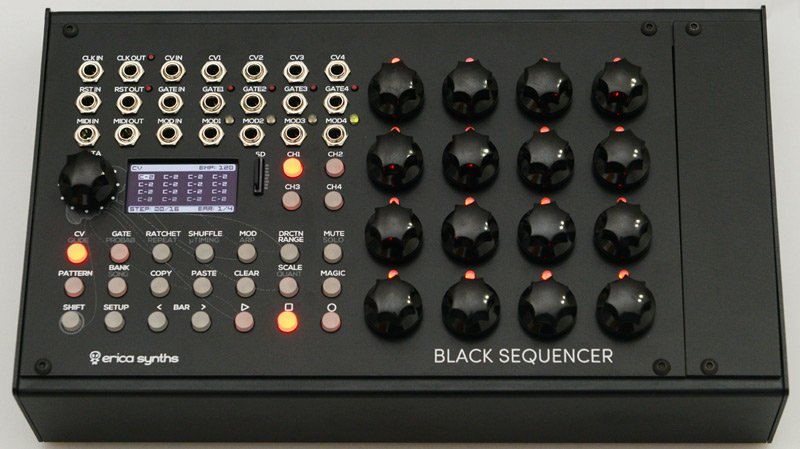Erica Synths Black Sequencer
Eurorack Format Step Sequencer
Author und Photos: Peter Kaminski
It was at Superbooth 2019 that Erica Synths presented their prototype of its step sequencer for the first time. All good things take their time and the Black Sequencer is now available. We were fortunate to receive a test unit before the product launch, albeit with a beta version of the firmware installed. The final release arrived at the end of October and the finished product will be available in December 2020.
Concept
The width of the module is 40HP with a depth of 25mm. The Black Sequencer offers four tracks for CV, gate and modulation data. A pattern can be up to 64 steps in length and there are 16 banks contain up to 16 patterns each. The patterns of a bank can be structured into 16 songs. The Black Sequencer saves the data to an SD-card.
Connections
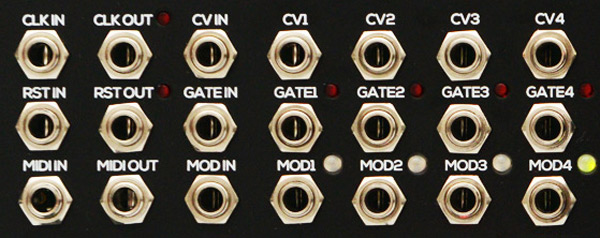
Let’s have a look at the connections first. On the right hand side you will find the outputs for CV, gate and modulation voltages for the four tracks. To the left there is one input each for CV, gate and modulation.The Black Sequencer also sports inputs for clock, reset, MIDI in- and output, all as 1/4” (3,5mm) TS sockets.
Handling

A central monochrome OLED-display (128 x 64 pixels) is flanked on the left by a comfortably large knob for data entry. Selecting one of the four tracks is accomplished by pressing the corresponding button next to the SD-card slot. Data entry for the 16 steps of notes, gate lengths etc. is handled by a grid of four by four equally large rotary encoders on the right hand half of the unit. The buttons “< BAR >” allow for moving forwards and backwards through sequences of 16 step blocks when needed. Underneath the display there are three rows of buttons, the top two of which are assigned dual functions that can be toggled by holding the SHIFT key. The alternate functionality is denoted by grey rather than white print.
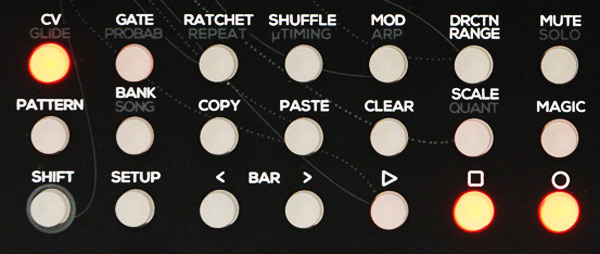
The lower row offers access to relevant system functions such as configuration, starting, stopping and saving the current configuration. Whenever a pattern has been changed the record-key denoted by a circle blinks. By the way, all buttons are illuminated by red LED’s as indicators. So much for the basic handling of the sequencer.
Configuration
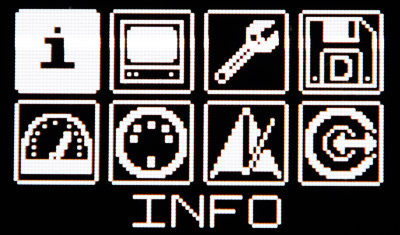
The “SETUP”- button activates a menu that allows access to the primary system parameters: calibration of the sequencer’s CV outputs, display parameters like OLED contrast, dimming and dialog pop-ups. The MIDI menu lets the user assign MIDI messages for each channel.
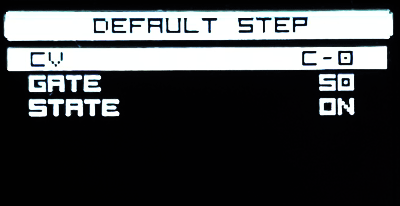
There is also a dialog to configure the standard settings of a step: note and gate length.
Play, Solo, Mute
Playback-speed is controlled by the internal clock that can be manipulated with the knob next to the display. When the setting is changed a pop-up showing the current BPM-value is displayed. Start and stop buttons can be found on the lower row (right of BAR, left of RECORD). Pressing stop resets the sequence to step number one.
Pressing SCALE lets the user define a clock division (1/2, 1/3 etc.) or multiplication as well as allowing for the realisation of triplets.
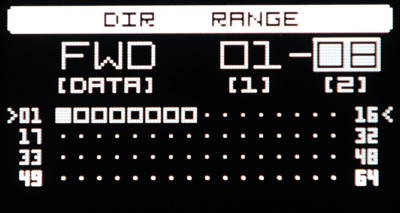
DRCTN RANGE accesses a dialog that controls the playback-direction of the current pattern: forwards, backwards, ping-pong and random. Also the playback range (start and end point) can be set by pressing one of the 16 encoders.
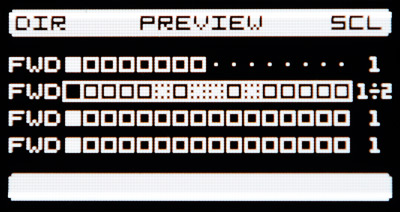
With the key combination SHIFT + DRCTN RANGE a 16 step overview of all four tracks appear including playback mode and clock divider/multiplier.
In connection with the four track select buttons the MUTE / SOLO (when holding SHIFT) functionality mutes or (not surprisingly ;-) solo’s single tracks.
Copy, Paste, Clear
It is important to note that parameters assigned to a track or step can easily be reset to the defaults. This is possible also for select parameters such as CV, gate, glide etc. Any or all parameters can also be copied from one track to another, or to an area of another track.
Notes and Scales
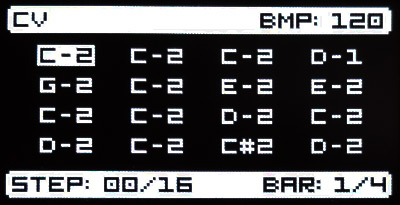
The CV key switches the Black Sequencer into CV mode. The display now shows the notes assigned to the current 16-step window. Turning one of the 16 rotary encoders directly modifies the respective step, which is emphasised by the appearance of a pop-up with the current value. Like I mentioned before this pop-up can be deactivated in the system settings.
SHIFT+CV activates the glide dialog. The glide between any two steps can be set between 0 (no glide) to 10 (max).
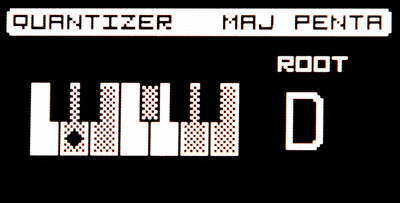
SHIFT+SCALE opens the quantisation-dialog where the user can either select a predefined scale, create a new scale and change the root note.
Gates and Timing
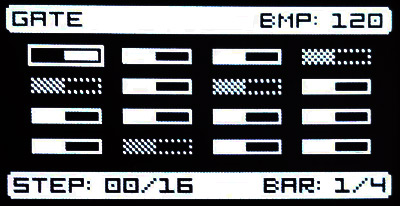
When selecting GATE mode the gate lengths of the 16 steps in the editing window are displayed. Turning any of the 16 knobs changes them instantly. Pressing the encoder once deactivates this gate, pressing it again re-activates it. Pressing the knob twice causes the step to be skipped, shortening the step lengths of the pattern accordingly. An interesting option for live performances is that gates can be combined by pressing on two encoders simultaneously. This causes only the CV of the first step in the group to be output.
Another interesting feature is the PORBAB (Gate Probability) function that allows the user to define the likelihood of the gate of a step to be output. The default is 1 (100%). Turning the encoder counterclockwise reduces it to 7/8, 3/4, 2/3, 1/2 etc up to 1/8. 1/4 e.g. means that the gate for this step is output on every fourth cycle. Turning the encoder clockwise displays the probability in percentages: 90%, 75%, 50%, 25% and 10%.
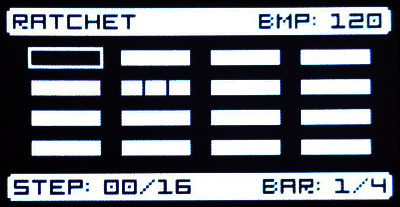
Another option to spice up the liveliness of a sequence is to employ the RATCHET functionality that distributes the gate of a step to a sequence of following gates. The 16 knobs allow for easy tuning up to a value of 8.
When ratcheting the same note is output by default. The ARP (Arpeggiator per Step) function lets the user change that by selecting an arpeggiator mode like MAJ, SEMI, BLK etc. The notes output depend on the selected scale, root note and ratcheting number.
The REPEAT function sets the number of repeats per step. The default of “1” can be upped to “8”. The number of steps per pattern change accordingly.
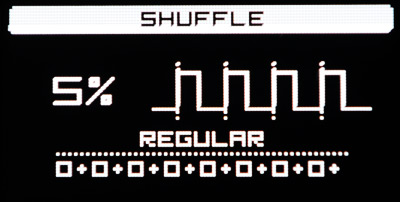
But there is more! SHUFFLE introduces more dynamic with respect to the timing by moving notes to off-beats.
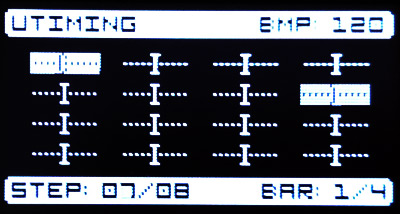
UTIMING (Microtiming) offers even finer grained control for every individual gate step. And then there is the track related MAGIC function that causes all or specific parameters to automatically be randomly influenced.
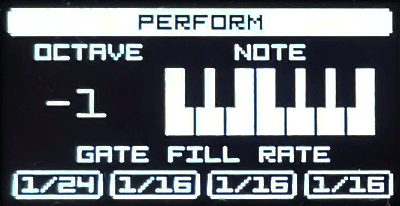
In the 1.0 release there is a perform dialog available for transposing by the first 12 encoders and rolls can be filled by pressing the encoders 13 until 16. The roll rate can ajusted by these four encoders.
Modulation
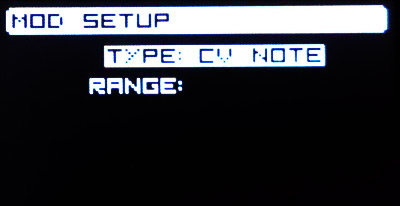
Let’s have a look at the modulation output that has a multitude of uses. Pressing SETUP+MODE accesses the configuration dialog.
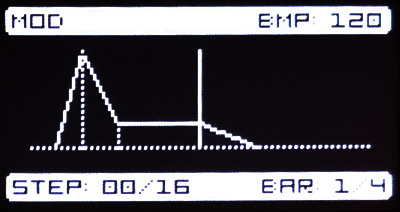
It is possible to output a defined voltage or a voltage corresponding to a note. There are also modes to output AD, ASR or ADSR envelopes.
This not only saves you from having to utilise a dedicated module–and conserves rack space–but the main advantage is that the duration of the envelopes is dynamically adjusted when using the ratcheting function. Experienced step sequencer users will know what I mean. You generally have to tune the envelope timing with a focus on the shortest notes so as not to slur them beyond recognition. Adaptive timing eliminates this issue. Additional modes are LFO and step LFO with amplitude and waveform adjustable per step.
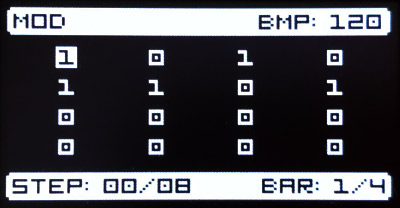
Another very interesting modulation mode is the trigger mode. Every step features a trigger impulse configured (turned on / off) by pressing on the corresponding encoder, enabling a tighter integration with drum and percussion modules. The flexibility is slightly hampered by the limited range of lock divisors but sufficient for a great many trigger patterns. Integrating a kick or snare is possibly without having to resort to another sequencer.
MIDI and Recording
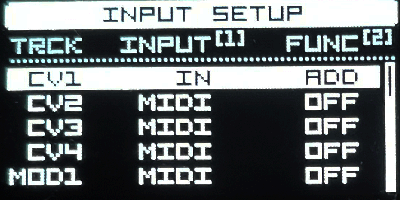
The Black Sequencer supports clock and reset in- and outputs and MIDI Clock. Since firmware 1.01 it is possible to use the VC- and MIDI-Input for example for key-transposition of a track. Thge assignment and function can be configure in the Input-Setup dialog. A real MIDI keyboard live recording with quantization will be available with the next firmware.

The firmware 1.02 offering also a recording via a connected MIDI or CV-Keyboard. There are tweo real time and two offline recording modes. OVERDUB records realtime and add notes and RECORDING overwrites existing notes. If the record function is armed the recording starting by pressing a key on the keyboard. In both mode a visual precounter can be activated via the POP-UP parameter in the recording settings.
With INSERT you can set a step by pushing an encoders and you can set the note value by the connected keyboard. With the FILL mode you can fill the track step-by-step with the MIDI keyboard. If you press a key in the FILL mode the next step will be selected. Also CV modulation input can be recorded.
Interview
Before the product launch of the Black Sequencer we had the opportunity to speak with Girts Ozolinš of Erica Synths.
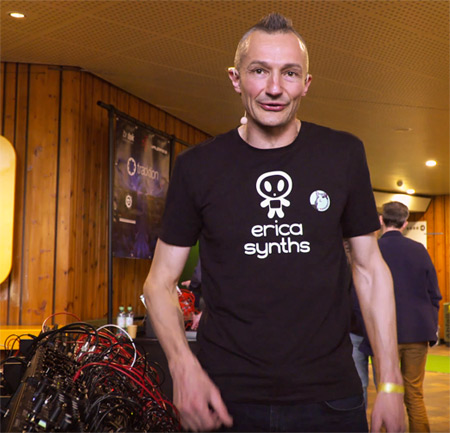
proaudio.de: There are a few step sequencer in the market so why Erica Synths develope another step sequencer?
Girts (Erica Synths): We start developments only, if we see that we can come up with something completely new and/or radically better/different than market offers. We have quite few eurorack sequencers in our office – I built plenty of DIY projects and we bought some really good sequencers for our residency studio. We have certain “filter” questions for a new gear: 1) can I operate it at certain depth without reading a user manual?, 2) is it enjoyable to use it? 3) is it enjoyable to use it after 5 minutes of operation? 4) what’s a value per HP in my performance system, meaning, does it contribute significantly to improve the performance system that has limited rack space? Most sequencers are very basic, without possibility to save settings or they feel like “pocket calculators” – too deep interfaces, too many operations to program the sequence, etc. Each product has its customer and a diversity makes world beautiful place, but we felt, there’s no sequencer for us. So we set ourselves a task to develop an ultimate CV/Gate sequencer that has that classical sequencer feel, but also all features, one may expect from a contemporary musical instrument. Also, as we have so many modules, we develop our product line so that we can come up with Erica Synths Systems. The Black Sequencer was a missing link for very powerful Black System.
proaudio.de: We talking on the Super Booth 2019 about the Black Sequencer the first time – so a long time ago. What was the reasons for the delay in releasing the device.
Girts (Erica Synths): Actually, we had even older prototype of the sequencer (see it attached) – as far I remember, it was developed on 2017, but we dropped that idea for several reasons. We resumed work on the Black Sequencer on 2019, and got it to reasonably usable state (beta testers were extremely happy about the initial firmware), but then other priorities (our standalone instrument Bassline DB-01) appeared. A sequencer on the Bassline DB-01 gave us considerable know-how on sequencers, and we decided to radically restructure and improve the firmware on the Black Sequencer. We have 300 Black Sequencers manufactured for almost a year, and they are expecting the firmware. Apart from constant questions form our customers about release date of the Black Sequencer, investment in a hardware is good motivation for us to complete the instrument as soon as possible.
Practical Usage
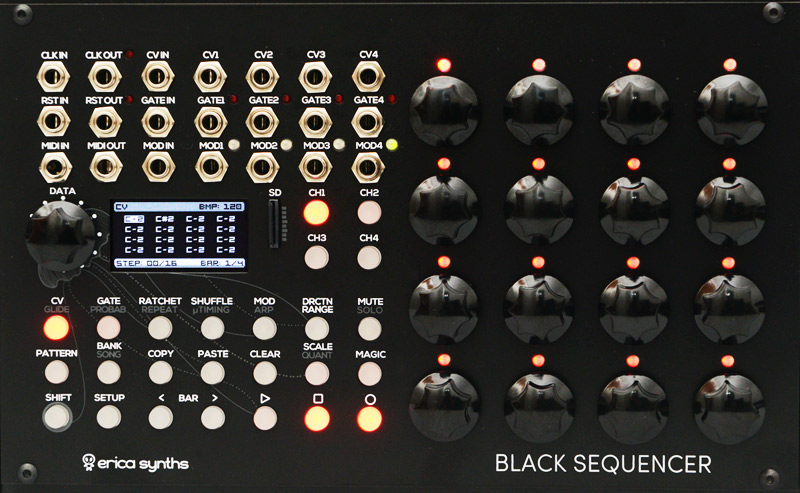
Power consumption tops out at 114mA at +12V and 24mA at -12V. This is quite moderate compared to other sequencer modules. +5V is not required.
The Black Sequencer offers instant access to a multitude of functions and usage of the SHIFT key has not been overdone. This is sadly not the case with many available sequencers. Either they are functionally very simple, some not even offering quantisation, or they are prohibitively complex. In my opinion Erica has found an optimal balance with the Black Sequencer. One slight gripe is that the grey lettering for the SHIFT enabled functions can be hard to read in bad lighting conditions. Maybe another color would have been better. But after a short time of using the unit one quickly learns where functions are located. Problem solved.
Thanks to the simultaneous presentation and easy accessibility of 16 parameters, very nicely and eminently readably displayed on the OLED display, setting and manipulating step values is easily handled. I’ve always longed for this! After a short period of getting to know the workflow the Black Sequencer can be played intuitively. Despite the high functional complexity of the unit a broad range of desirable possibilities has been implemented.
I am very enthusiastic about the timing functionality, especially the ratcheting, probability and micro-timing aspects that allow me to create highly dynamic sequences. This encapsulates a range of functions that also make the Black Sequencer interesting for live performances.
Bottom line
The price of the Black Sequencer is set at about 600 Euro. I have to say that this device is the best currently available step sequencer in Eurorack format, setting a very high bar for any future contenders.
Currently missing functions for recording and transposing live keyboard input as well as CV input support will be available in the next firmware upgrade. Yet even now I consider this sequencer an ideal complement for existing step sequencers like the XOR NerdSEQ. It's approach to programmability is completely different, resulting in very different musical results.
The Black Sequencer is optimised to be used as a step sequencer, and I believe this is as good as it gets. It is a great product for studio work with a great potential for live performances.
 How to resolve AdBlock issue?
How to resolve AdBlock issue? 